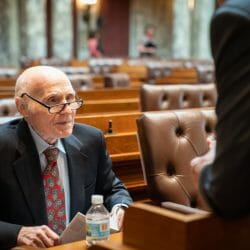There’s a Rule for That
From car seats to clean air, federal and state regulations influence our lives.
With two small children at home, Susan Webb Yackee goes through a lot of peanut butter.
But although many Americans don’t think much about what’s in this pantry staple, Yackee is one of few who know that the childhood favorite must contain at least 90 percent peanuts, as well as how that standard was established.
Yackee, a UW associate professor of public affairs and political science, is a leading scholar on the regulatory policy-making process at federal agencies. She’s published groundbreaking studies on the rulemaking process, a relatively transparent and potentially democratizing system that affects standards for everything from child car seats to organic food, clean air to derivatives trading.
She has also been studying Wisconsin’s rulemaking process, which features greater legislative involvement than that at the federal level.
“Regulatory policymaking can seem overly legalistic and is somewhat removed from the fast-paced world of legislative policymaking, but the stakes are equally high,” Yackee says. “All of us, when we walk out of our houses every morning, are impacted by existing rules and regulations, and just for that, we should be concerned about them and who influences the rulemaking process.”
It’s especially important for students who want to pursue careers in public affairs to study Yackee’s work because an understanding of rulemaking is critical, says John Coleman, professor and chair of the political science department.
“If you want to be effective in those positions, you’d better understand how rulemaking works, because it’s where an awful lot of the action happens,” he says.
While anyone who’s taken a high school civics course knows the basics of how a bill becomes a law, the process of rulemaking, which can have as much — or more — influence on the daily life of Americans, is lesser known and studied.
Modern rulemaking dates to 1946, when Congress standardized the process for crafting rules and put in place a system that requires an element of public participation. When a federal agency drafts a potential rule, it opens a period for public comment, during which any citizen or group may provide feedback. Before an agency puts a finalized rule in place, it is required to carefully consider comments from the public; if the rule doesn’t reflect those opinions, the agency is compelled by law to explain why. The state of Wisconsin has similar opportunities for public participation during rulemaking.
“It’s a very deliberative process where citizens, if they wanted to, could get involved and see a response to their feedback,” Yackee says. “I’ve found this whole process has the prospect of a very democratizing effect on the U.S. citizenry.”
The process tends to move faster than many people believe. This year, Yackee and her husband, Jason Webb Yackee, an assistant professor in the UW Law School, published a first-of-its-kind evaluation of the length of time it takes for rules to be written and put in place. The average is fourteen months.
Yackee’s research has also shown that the process has been responsive to input from the public, particularly when represented by interest groups. Her study of nearly seventeen hundred comments on forty rules issued by federal agencies, conducted with Amy McKay, an assistant professor at Georgia State University, found strong evidence showing that federal officials listen to such groups and tend to favor the side that dominates the comments.
But while that finding signals that the public can influence the rules that will govern them, few individual citizens, compared to organized groups, participate in the process.
“While participation has been poor in the past for average citizens, the ease of the Internet and social media means citizens will be able to provide informed opinions to regulators,” Yackee says.
Interest groups with a stake in a rule tend to be intimately involved in the writing of draft rules, her research shows. And in some ways, they bring a positive influence, she says, because rules are crafted using data from those who will be most affected. However, she’s concerned about the transparency of the “potentially nefarious” side of the behind-the-scenes process.
“People who participate in lobbying outside the standard rules process are better able to obtain the changes they’d like to see within draft rules than those that don’t participate,” she says.
Published in the Winter 2011 issue



Comments
No comments posted yet.